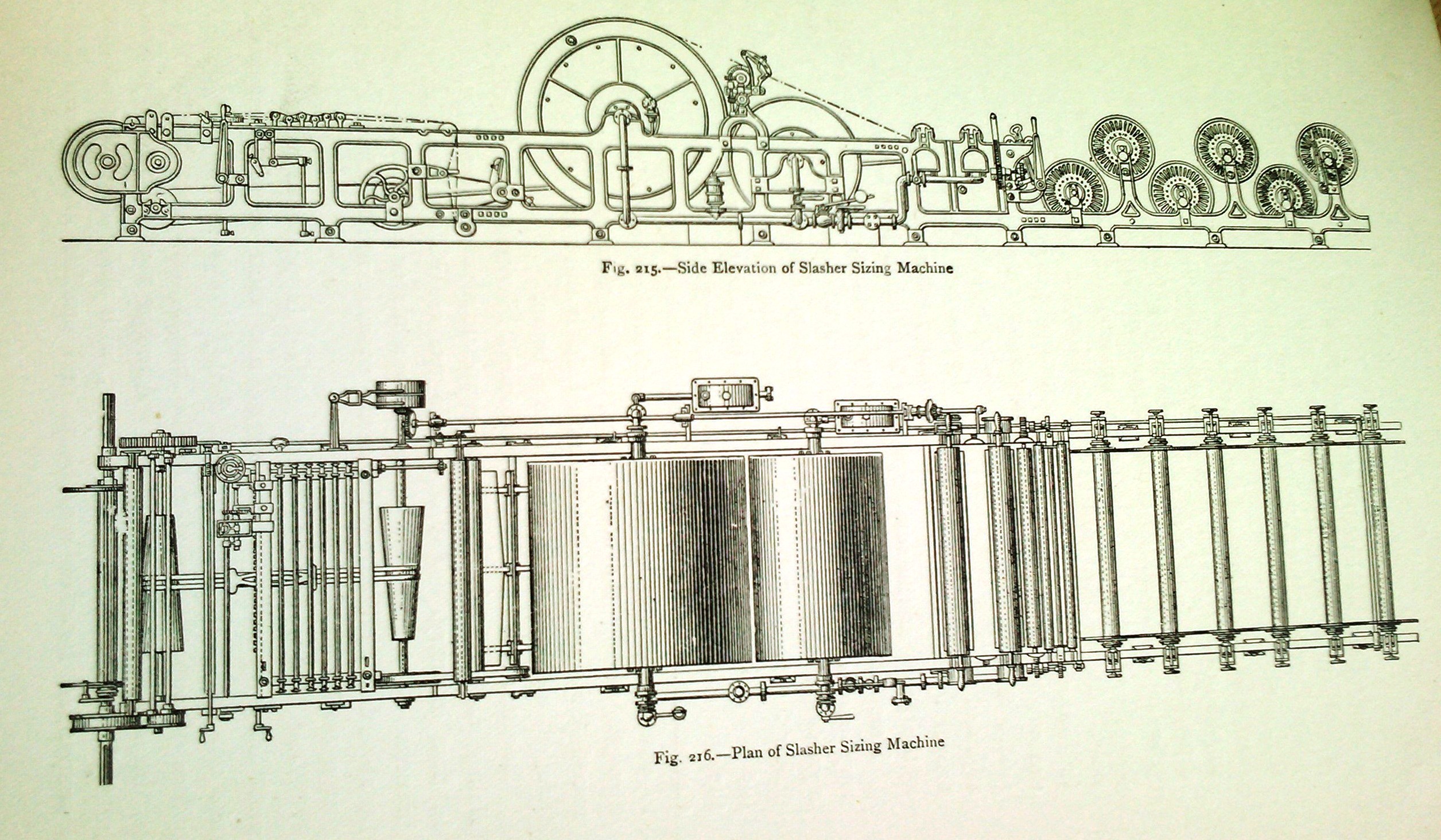Textile sizing machine on:
[Wikipedia]
[Google]
[Amazon]
 The technique of
The technique of
 The technique of
The technique of sizing
Sizing or size is a substance that is applied to, or incorporated into, other materials—especially papers and textiles—to act as a protective filler or glaze. Sizing is used in papermaking and textile manufacturing to change the absorption ...
a warp
Warp, warped or warping may refer to:
Arts and entertainment Books and comics
* WaRP Graphics, an alternative comics publisher
* ''Warp'' (First Comics), comic book series published by First Comics based on the play ''Warp!''
* Warp (comics), a ...
was mechanised during the nineteenth century when William Radcliffe
William Radcliffe (1761?, in Mellor, Derbyshire – 20 May 1842, in StockportDavid J. Jeremy"Radcliffe, William (1761?–1842)" ''Oxford Dictionary of National Biography'', Oxford University Press, 2004, accessed 9 July 2008) was a British inventor ...
and his assistant Thomas Johnson invented the sizing machine. The purpose of introducing ''size'', which is either a starch
Starch or amylum is a polymeric carbohydrate consisting of numerous glucose units joined by glycosidic bonds. This polysaccharide is produced by most green plants for energy storage. Worldwide, it is the most common carbohydrate in human diets ...
y substance for cotton
Cotton is a soft, fluffy staple fiber that grows in a boll, or protective case, around the seeds of the cotton plants of the genus ''Gossypium'' in the mallow family Malvaceae. The fiber is almost pure cellulose, and can contain minor perce ...
or gelatinous mixture for wool
Wool is the textile fibre obtained from sheep and other mammals, especially goats, rabbits, and camelids. The term may also refer to inorganic materials, such as mineral wool and glass wool, that have properties similar to animal wool.
As ...
len fibre, is to reduce the chances of threads fraying and breaking due to the friction of the weaving
Weaving is a method of textile production in which two distinct sets of yarns or threads are interlaced at right angles to form a fabric or cloth. Other methods are knitting, crocheting, felting, and braiding or plaiting. The longitudinal th ...
process. The size stiffens the thread and helps the fibres lie closely together. Many recipes for size can be found in textile manufacturing books. The recipes include flour
Flour is a powder made by grinding raw grains, roots, beans, nuts, or seeds. Flours are used to make many different foods. Cereal flour, particularly wheat flour, is the main ingredient of bread, which is a staple food for many culture ...
, sago, china clay, types of soap
Soap is a salt of a fatty acid used in a variety of cleansing and lubricating products. In a domestic setting, soaps are surfactants usually used for washing, bathing, and other types of housekeeping. In industrial settings, soaps are use ...
, fat
In nutrition science, nutrition, biology, and chemistry, fat usually means any ester of fatty acids, or a mixture of such chemical compound, compounds, most commonly those that occur in living beings or in food.
The term often refers spec ...
s and some chemicals.
Before mechanisation, the sizing process was a time-consuming task. The weaver painted the size onto the warp as it lay on the loom
A loom is a device used to weave cloth and tapestry. The basic purpose of any loom is to hold the warp threads under tension to facilitate the interweaving of the weft threads. The precise shape of the loom and its mechanics may vary, but th ...
, then fanned it dry before weaving the cloth. The sizing machine improved the process by sizing a warp before putting it into the loom. The warp threads are first wound onto a large beam, which is then placed at one end of the sizing machine. Then the warp is drawn off the beam and passes through a bath of boiling size, between sets of rollers and cooled, dried and rewound onto another beam. It is then ready to be woven.
An example of a sizing machine made in 1919 by Howard and Bullough Ltd, Accrington
Accrington is a town in the Hyndburn borough of Lancashire, England. It lies about east of Blackburn, west of Burnley, east of Preston, north of Manchester and is situated on the culverted River Hyndburn. Commonly abbreviated by locals to ...
, Lancashire, England, can be seen in the tape size room of Queen Street Mill
Queen Street Mill is a former weaving mill in Harle Syke, a suburb to the north-east of Burnley, Lancashire, that is a It was built in 1894 for the Queen Street Manufacturing Company. It closed on 12 March 1982 and was mothballed, but was su ...
Textile Museum, Burnley
Burnley () is a town and the administrative centre of the wider Borough of Burnley in Lancashire, England, with a 2001 population of 73,021. It is north of Manchester and east of Preston, at the confluence of the River Calder and River Bru ...
in Lancashire. Other early twentieth century sizing machine manufacturers were Brook and Crowther, T., Ltd of Huddersfield
Huddersfield is a market town in the Kirklees district in West Yorkshire, England. It is the administrative centre and largest settlement in the Kirklees district. The town is in the foothills of the Pennines. The River Holme's confluence into ...
, Butterworth and Dickinson Ltd, Burnley and Platt Bros & Co. Ltd.
References
{{Weaving Textile machinery